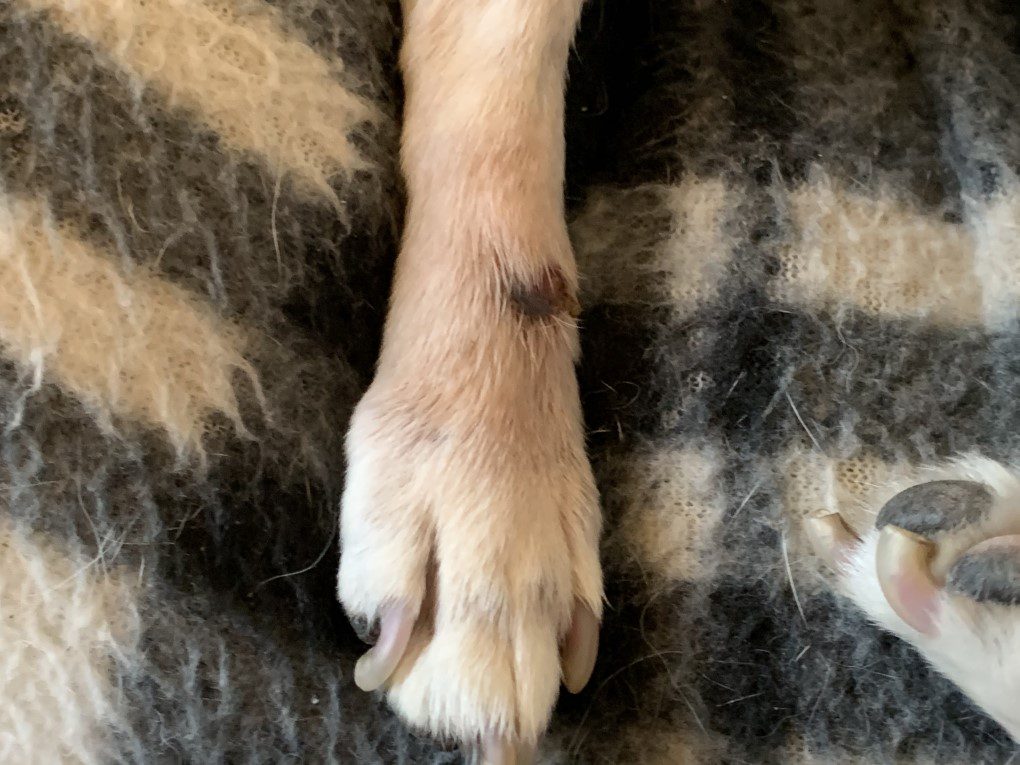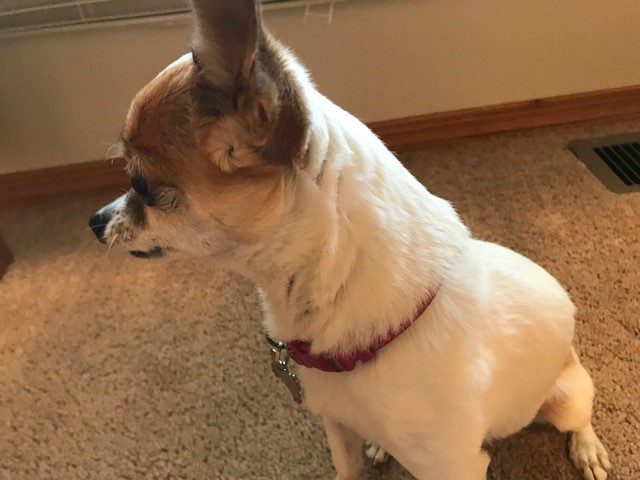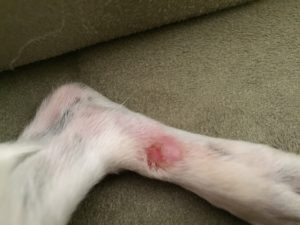This article about my dog’s lick granuloma was first published in June 2016 and has been updated.
I am dealing with a nightmare skin condition called lick granuloma. My sweet little Pebbles has developed this skin condition just in the last year. I have been giving her oral medications from the Veterinarian and putting a prescribed topical medication on the affected area and she goes in twice a week for laser treatments.
That was in June 2016 and here it is November 2019 and we are still dealing with it off and on.

I know I am not the only person that is dealing with this terrible skin condition known as lick granuloma, so I decided to talk about it here. I have done lots of research and consultations with our veterinarian and this is what I have learned and I want to share it with you.
WHAT IS IT?
- This skin condition has many names. It is called:
- Acral lick dermatitis
- Acral lick granuloma
- Acral lick furunculosis
- Acral lick lesion
- Acral pruritic nodule
- ALD
According to Ian Spiegel, VMD, MHS, DACVD, lick granuloma is a self-induced dermatologic condition that develops from compulsive or chronic incessant licking in one or more areas (usually a foot or leg area). It is one of the most challenging and frustrating conditions for veterinarians treat. Thus my nightmare!
WHAT ARE THE CAUSES?
There are many factors that may trigger excessive licking resulting in a lick granuloma. These are:
- Itchy skin
- Pain, joint or bone
- Boredom
- Stress
- Obsessive-compulsive disorder
Itchy skin may be caused by things like allergies or from foreign material such as a suture, grass awn, thistle spine, a splinter, bee stinger, metal, or gravel.
Pain may be from a previous injury, mites, cancer, orthopedic disorders like arthritis, joint disease or bone pain.
Boredom may be a cause if you have an energetic dog that is left on his own for many hours of the day.
Stress can be caused by anxiety. It can be triggered by environmental things such as a new child, or pet in the home. A death in the family or moving may be causes for anxiety also.
Obsessive-compulsive disorder can also be a factor. Animals, as well as humans, can be diagnosed with this disorder.
It becomes a nightmare to try to treat because the skin is so deeply affected that clear down to the base layer of the skin there can be little pockets of bacteria, broken hair follicles, plugged and scarred oil glands and dilated inflamed capillaries.
It is also believed that the lick granuloma is exacerbated by the idea that local cells or nerves become damaged and release endorphins that act not only as strong analgesics but also provide a natural “high” that just leads to more licking. It becomes a seemingly impossible cycle to break.
WHAT ARE THE TREATMENTS?
The main concern is the infection, so that is usually the first treatment. The infection often requires 6 to 12 weeks of oral antibiotics. Because each dog is unique, what works for one may not work for another. Therefore, it may be necessary to try different treatments until you find one that works for your dog.
My Veterinarian, Dr. Jeff Herod, DVM, prescribes a broad-spectrum antibiotic called Rilexine. As always, consult with your veterinarian before starting any type of treatment. Some of these treatments may include:
- Anti-inflammatory medications
- Topical medications
- Electronic “bandages”
- Physical barriers (bandages, cone collars)
- Behavioral modification
- Surgery or laser treatments
While lick granulomas are difficult to cure, they are usually manageable. This is rarely a life-threatening condition, although it is irritating for the dog, and as I can attest to, for the owner as well. Dogs that receive early treatment have a much better chance for a favorable outcome than dogs with advanced conditions.
Pebbles is still on antibiotics and so far the laser treatments don’t seem to be helping much. We will soon be making a trip to see our veterinarian again to perhaps try some anxiety medications. I hope we can solve this problem soon, it is distressing to me to see this open wound on her tiny little leg and watch her excessively lick it. I am hopeful that we will find the right treatment and thankful that we at least began treatment early.
UPDATE: November 2019
Believe it or not, we are still dealing with a lick granuloma. Every time we get it healed, she continues to lick it and continues to re-infect it. When I wrote this in 2016 I called it a nightmare — now I realize how true that statement really was. Even veterinarians don’t know how to cure it for good.
Since nothing else has worked, as well as the antibiotic, I’ve been putting a topical ointment from the vet on it every morning and afternoon and again in the evening and she has to wear her Elizabethan collar every day (some call this a “collar of shame, I think that name is shameful! why should she be ashamed?).

Then I wrap it every night so she won’t have to wear the collar to bed. The wrap won’t work for during the day because she just keeps licking and biting it until she gets it pulled down far enough she can lick the spot, or if you don’t wrap the entire leg, she starts a new one.
I have finally pinpointed the cause of Pebble’s granuloma. It all began when we brought our little Remedy home in May 2015.
Until then it had only been my husband, myself, and Chico, and Pebbles. Hers is caused by stress. It began with the stress of a new dog. Another female.
We get the lick granuloma healed up and when another stressor comes along it’s back. When I puppy sat for my brother and sister-in-law, when my step-son & daughter-in-law visit with their Great Dane, or my step-daughter visits with her little Pomeranian.
At least I now know what causes hers. But it will be something we will always have to deal with.

